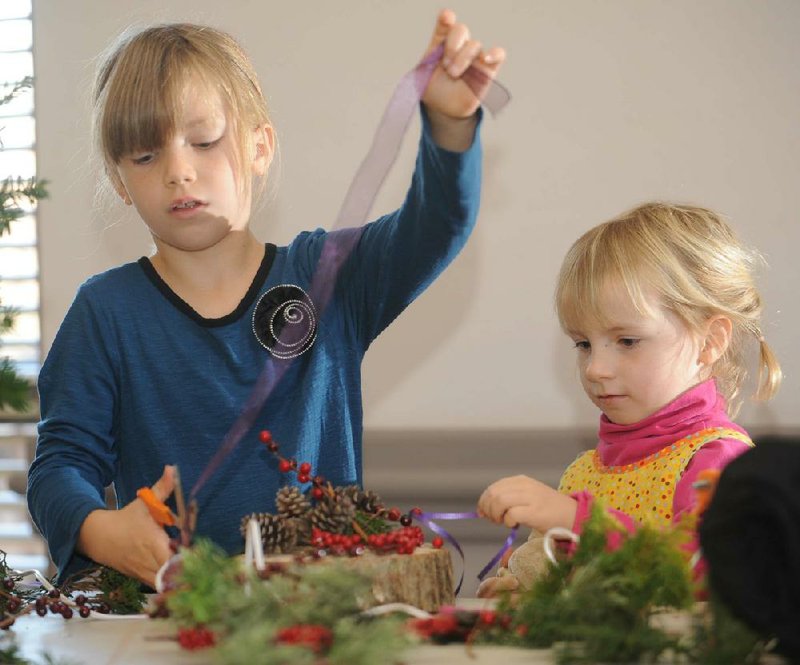LITTLE ROCK — For Christians who follow the liturgical seasons of the church, Advent marks the beginning of a new year. It’s a season of music and ritual suffused with a building sense of anticipation as Christmas and the celebration of Christ’s birth near.
Advent starts Sunday and with it the waiting begins.
While the season’s focus is on awaiting the Christ child’s arrival, Advent is also a time to anticipate the Second Coming of Jesus.
“Advent is a time when we are anticipating the end times — the promise that Christ will return and in that return all things contrary to the will of God will come to an end,” said the Rev. Mary Vano, pastor of St. Margaret’s Episcopal Church in Little Rock.
At St. Margaret’s, the familiar sights and sounds of Christmas are put off until the night of Dec. 24. For the next four Sundays, parishioners will cultivate a sense of watchfulness. But staving off the commercialized version of the holiday, where Christmas music begins blaring from mall speakers even before Thanksgiving, is a challenge, Vano said.
“We find ourselves out of step with the rest of the culture when we resist in moving straight into Christmas,” she said.
That’s not to say that Advent is without traditions of its own. It’s customary in many churches for members to make Advent wreaths to take home. The wreath, a circle, is a symbol of eternity and it includes four candles to represent the four Sundays of Advent.
Many churches have Advent wreaths prominently displayed in the sanctuary, and a candle is lit each week during worship.
“The candles shorten as they burn and it’s a practice of watch- ing time pass and being present in the moment,” Vano said. “It’s learning to be still and to be ready for God.”
At First Presbyterian Church in Fort Smith, music helps set the tone for Advent, with hymns focusing on the Second Coming or the arrival of the Christ child, said music director Stanley Livengood. Livengood said they try to hold off a bit on Christmas carols, but by the second or third Sunday some start to creep in.
“We might use a familiar carol with an Advent text,” he said. “There’s a version of ‘Joy to the World’ with an Advent text, or we might use one verse of a Christmas carol ... to give a little taste of the beautiful music to come.”
Advent does have music all its own, and one of the most popular songs is “O Come, O Come, Emmanuel.” Written by John Mason Neale, the song is based on the “O” antiphons or chants that were often sung during evening services in the medieval church. The chants were particularly common in monasteries.
Livengood said another favorite is “Come Thou Long-Expected Jesus,” written by prolific hymn writer Charles Wesley.
“A personal one of my favorites is ‘Let All Mortal Flesh Keep Silence,’” Livengood said. “It emphasizes more the Second Coming aspect. It’s a beautiful tune in a minor key.”
The music, Livengood said, helps set a tone of worship.
“It helps us anticipate,” he said. “Of course we know the story, but when we really meditate on it, and the music helps us do that, it really takes on a deeper meaning. You think about what the family went through, traveling on a donkey with nowhere to stay. ... Our music helps us remember all of that during Advent.”
Livengood said members look forward to the music, Advent songs and Christmas carols each year.
“They have a longevity,” he said. “We’ve sung them since childhood and we’re so fond of them. They never change. For many people it’s their favorite time of year.”
Sister Rachel Dietz, a Benedictine nun at St. Scholastica Monastery in Fort Smith, will lead an “Advent Day of Recollection” on Thursday. Dietz said the repeated cycle of Advent is a reminder “that we need Christ over and over in many different ways.”
“The church uses these four weeks to remember we experience God’s presence in our lives in many ways,” she said. “Christ comes all the time. It’s not just once. There are critical moments in human life when you know there’s a power higher than you present and I choose to believe that’s God’s presence.”
The day-long retreat will focus on waiting alongside Jesus’ mother Mary. Information is at stscho.org.
“It isn’t just waiting with Mary until her baby is born. Mary spent her life waiting,” she said, and added that in today’s world waiting isn’t easy. “Waiting is un-American. It’s instant this, instant that. We want instant everything and that’s just not how life is.”
Dietz said Mary not only waited for Jesus’ birth, but waited throughout his life, even until the end.
“I can’t imagine what her waiting was like between the Last Supper and Jesus’ death,” she said. “I’ll tie all this in with the experience parents have today ... and bring in situations where God intervenes in our lives and gives us courage to keep going when things look pretty bleak.”
As for Vano, she loves the sense of anticipation that Advent brings. She said it heightens the meaning of the season.
“The most important thing Mary ever did was she said, ‘Let it be with me according to Your will.’ She said yes to God,” Vano said. “Advent reminds us these great promises are out there for us. We can make them real by saying ‘Yes, let it be according to Your will.’”
Religion, Pages 12 on 12/01/2012

